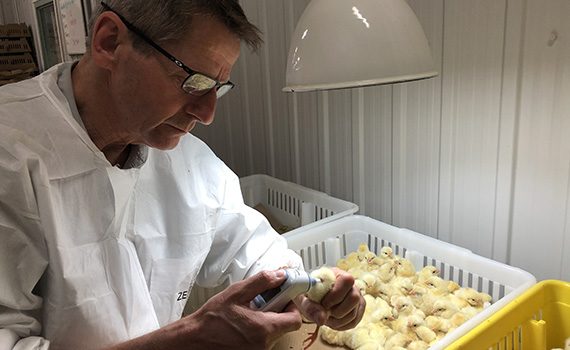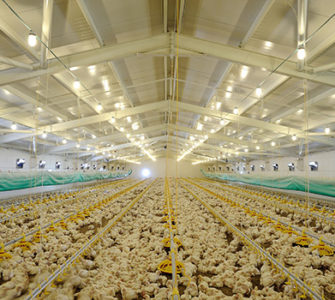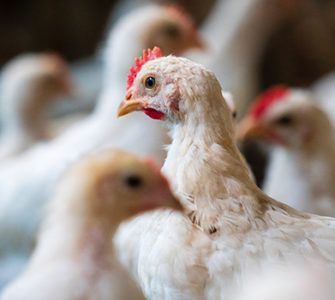A few tools to improve brooding, not antibiotic alternatives, are key to NE prevention
By Reg Smith
Vice President, Operations
Atlantic Poultry
Nova Scotia, Canada
Formerly Chair, British Poultry Council’s Antibiotic Stewardship strategy
A recent report in Poultry Health Today about navigating the maze of antibiotic alternatives for control and prevention of necrotic enteritis (NE) caught my attention, and I couldn’t resist sharing a NE solution that I have found effective in flocks raised without antibiotics.
Before I came to my current position in Canada, one of my roles was chair of the British Poultry Council’s Antibiotic Stewardship (BPCAS) strategy. The British Poultry Council is an industry group representing nearly 90% of the UK’s poultry-meat sector. With our BPCAS strategy, we managed to initiate more than an 80% reduction in antibiotic use in the British meat industry between 2012 and 2018. This achievement was heralded as an example of responsible farming within Europe, but it wasn’t an easy accomplishment.
In the UK, antibiotics used for improving feed conversion and growth rate were withdrawn almost overnight in the late 1990s. The move was driven partly by competitive “one-upmanship” between industry players and partly by retail pressures on the supply chain. The immediate effect was a steep rise in cases of NE across the majority of broilers produced, usually between 18 and 26 days of age and often coinciding with maximum coccidial shedding.
Alternative products, such as feed additives that are supposed to enhance gut health, did little to quell the problem. Ultimately, therapeutic antibiotics were required to prevent significant welfare insults to the birds.
‘Fantastic’ claims
In the year or so that followed, another array of products appeared with fantastic claims about their effectiveness upon — yes, you’ve guessed it — NE, when in fact none of the products were very effective. Flocks raised without antibiotics had to be treated for NE and, too often, retreated. It became clear that focusing solely on alternative products was an exercise in near futility and that we had to completely rethink our approach to managing NE.
I think it’s fair to say our solution to the NE problem came about due to frustration and, to some extent, by happenstance. We knew birds were still developing their intestines during the first week of life. We theorized that if suboptimal brooding impaired that development, proper gastrointestinal tract function was inhibited, thus potentially setting the stage for the development of NE later.
We started measuring everything we could during the first week of brooding — even though we weren’t exactly sure what we were looking for. The assessment of vent temperatures, however, showed they were not what they should be. We concluded we weren’t doing a good job with brooding management, particularly in achieving even brooding temperature.
That’s when the real solution to NE started to reveal itself, and it became apparent the remedy lies in the hands of the farmer.
The error of our ways
Although young broiler chicks are precocial — meaning they are able to start finding food and water shortly after emerging from the egg — that doesn’t mean they are completely able to survive without further support from the parent.
If you watch a hen looking after newly hatched chicks, you will see the chicks move out from the hen to forage around the mother, but periodically, they get cold and go back under the hen to warm up. In this way they maintain their optimal temperature.
Conversely, our brooding systems are often designed to heat the whole house. We have probes to measure the temperature, and that measurement is how the farmer decides if the brooding temperature is correct. However, consider that the chick stands around 2 inches (5.08 centimeters) off the bedding, and our temperature probes are 12 inches (30.48 centimeters) or more off the floor.
In addition, poultry houses often lack recirculation fans, which leads to uneven temperatures across the floor and from floor to ceiling. In my experience with older barns, the range in temperature between what’s measured at the walls versus the center of the house can be as much as a 30-degree difference. Chicks that end up near external walls of the house become chilled, and if they don’t die, they don’t start as well as chicks in the middle of the house.
You may not see any clinical signs of NE during the first couple of weeks, but when the bird really starts to grow, the impact of uneven brooding becomes apparent and is evidenced by various gut disorders. NE is commonly diagnosed.
Measure and adjust
The astute farmer can spot an uneven-brooding problem when chicks are as young as 2 to 3 days of age and well before clinical signs of NE develop. Chicks look healthy upon arrival at the farm, but in a few days, some variability or unevenness can be noted. We at BPCAS assumed that variability is the first indication chicks are not getting off to a good start due to uneven brooding temperatures across the barn floor.
How can a farmer check that his brooding conditions are effective for all the chicks in the barn? Every farmer involved with the BPCAS initiative adopted the adage, “You don’t manage what you don’t measure,” and started checking bedding temperatures. The first few days of a flock’s life, they primarily used infrared thermometers. The electronic probe connected to the control system was used but was considered secondary.
The target temperature before the chicks arrived at the house was generally 91.4° F (33° C). To prevent overheating of chicks, the brooding temperature would be set slightly lower if the poultry house had underfloor heating or if humidity was high since moist air can transfer heat.
Six hours after chicks were placed, farmers checked chick vent temperatures using Thermoscan® ear thermometers. Chicks around the walls of the barn as well as those in the center and at the ends of the barn were checked. At this stage, the vent temperature should be 104° F (40° C). If it’s 103° F (39.4° C), there’s no need to worry, but more than 1-degree drop in temperature indicates the brooding temperature needs to be raised.
At 24 hours, farmers checked for “crop fill.” They simply felt the birds’ crop to ensure there was a small ball of softish feed inside to demonstrate chicks are eating and drinking. The Internet is replete with articles and videos about how to check for crop fill.
It’s rare to find a large number of chicks without crop fill, but sometimes crop fill is found to be uneven in a flock, indicating some chicks need help finding food. This problem can be remedied by placing birds on long strips of paper covered with food. Bright light the first few days can also help.
Mortality declined, NE disappeared
Once farmers started carrying out these simple but detailed steps to improve brooding within the first few days of life, two things happened. The 7-day mortality dropped, and NE — previously a constant blight for the industry raising flocks without antibiotics — disappeared. NE now is largely a thing of the past. If NE does appear, brooding management on that farm needs to be revisited.
Other improvements that should be made throughout the production system include making sure water lines are clean and that ventilation is good. Antibiotic alternatives such as probiotics, prebiotics and additional feed additives like butyrate, a short-chain fatty acid, can be helpful and invariably formed part of a group of successful strategies employed, but they did not become the only strategy.
My overall take from this experience is that antibiotics were so effective over the years, their use masked suboptimal husbandry practices. With the help of a few inexpensive tools and a greater focus on basic brooding — especially proper house temperature — we not only achieved better overall husbandry, we solved the problem of NE.
Originally from a broiler-farming family in the UK, Smith studied at The National Institute of Poultry Husbandry then managed farms with layers, broilers, game and turkeys. After a stint with the British Army as a tank troop commander followed by a backpacking trip throughout Africa, Smith returned to the poultry industry, starting in Zimbabwe. He then returned to the UK, where he ultimately became vice-president of agricultural operations for a large integrated poultry operation before joining Atlantic Poultry in Nova Scotia.
Editor’s note: The opinions and advice presented in this article belong to the author and, as such, are presented here as points of view, not specific recommendations by Poultry Health Today.
Posted on May 20, 2019

















